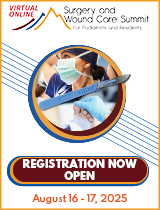|
|
|

|
Search
02/15/2021 Bryan J. Roth, DPM
CPME 320 and Wound Care Rotations
The Council on Podiatric Medical Education (CPME)
320 Document, Standards and Requirements for
Approval of Podiatric Medicine and Surgery
Residencies, is currently under revision. There
has been much discussion within our profession
regarding the direction of the 320 Document, which
impacts residency training and thus, the future of
our profession. What exactly does our profession
desire? Parity and privileging are frequently
discussed in podiatry, however instead of
discussion, I believe one must practice it and not
simply discuss it.
In my opinion, the 320 document affects everyone
in our profession regardless of their involvement
in residency education. The document guides the
future of the practicing podiatrist and eventually
the community standards of how we are evaluated.
I believe two areas are critical to our future and
should be included in the CPME 320 document: the
required use of system-based milestones and a
rotation in wound care.
As a residency director, I am asked by former
residents and facilities to complete medical staff
privileging forms. These documents typically
reference performance and competence of
comprehensive history and physicals (H&Ps) and
surgical procedures. Not only are the facilities
looking for training and experience in the form of
numbers, they are looking for competence related
to the H&Ps and procedures.
Competence is difficult to verify within the
format of non-outcome-based assessments.
Podiatric residency training is heavily weighted
on achieving numbers, or Minimum Activity Volume
(MAVs), in lieu of standard milestone-based
assessments. The American College of Graduate
Medical Education (ACGME) has been using
milestones, outcome-based assessments, since 2013.
Podiatric milestones would create a standard for
emerging practitioners and transition from using
perceived competence-based MAVs and align with our
ACGME counterparts.
In addition, a wound care rotation must be
mandatory for all podiatric residents and include
exposure to the diabetic foot. Upon completion of
podiatric residency training, the emerging
practitioner must possess the knowledge and
armamentarium to effectively treat a wide variety
of wound pathology. Simply obtaining MAVs spread
across three years of training does not provide
the necessary exposure, nor allow for the
development of evidence-based treatment
algorithms, as a designated rotation would
provide.
Our counterparts, the ACGME and the American Board
of Orthopaedic Surgery, completed the Foot and
Ankle Milestone project in 2015 which was
implemented for assessment of fellows in ACGME
foot and ankle fellowships. The document includes
evaluation of a fellow’s competency in the medical
knowledge and patient care of the diabetic foot.
The re-write committee should be acting in the
best interest of our learners and our profession.
We need to remember, there isn’t anything we do
that cannot be replaced by another medical
professional. It is imperative we are the best at
what we do to avoid being replaced. I firmly
believe podiatry would benefit from both the
implementation of milestones and a mandatory wound
care rotation.
Bryan J. Roth, DPM, Phoenix, AZ
Other messages in this thread:
02/17/2021 Steven Kravitz, DPM
CPME 320 and Wound Care Rotations (Bryan J. Roth, DPM)
I like to take the opportunity to make brief
comments regarding Dr. Roth’s article on wound
care rotations in the new CPME 320 rewrite and
training in podiatric medicine. He is spot on
target and makes a very good logical argument for
the rationale to ensure that going forward all
podiatrists are trained in residency training
programs in the basic concepts of wound healing.
Wound healing has taken on a different form for
podiatric medicine and allowed it to become
mainstream, fully engaged with equal parity across
the field, for treatment in our area of anatomical
special specialty and provide full services for
same. I mentioned an article published in this
newsletter a couple weeks ago that for the
subspecialty of wound healing parity is there.
Wound healing is the only subspecialty were
podiatrists can be certified with same exam as our
allopathic counterparts, available only and
specifically to MD, DPM, and DO.
While parity found in wound healing may not yet be
the current standard of care in all aspects of
podiatric medicine it is nonetheless the model
that serves a purpose all of medicine can be
striving for. Dr. Dan Davis, past president of the
APMA as stated from the podium multiple times and
written in this publication that certification
exam in wound healing offered by Academy of
Physicians in Wound Healing (and its certification
exam Council for Medical Education and Testing)
are the model for the future going forward.
Something all medicine will one day emulate.
While he rightfully describes this groundbreaking
I foresee the day when this will be customary
throughout medicine. We need to establish training
programs that demonstrate our skills in order for
that to occur. The first step is long past due and
is described nicely with Dr. Roth’s article
February 15 in this publication. It is about time
wound healing take its rightful place for all
graduate training of podiatric physicians.
Steven Kravitz, DPM, Winston-Salem, NC
|
| |

|
|







